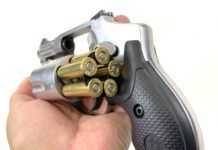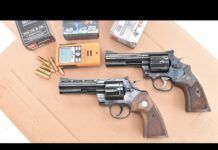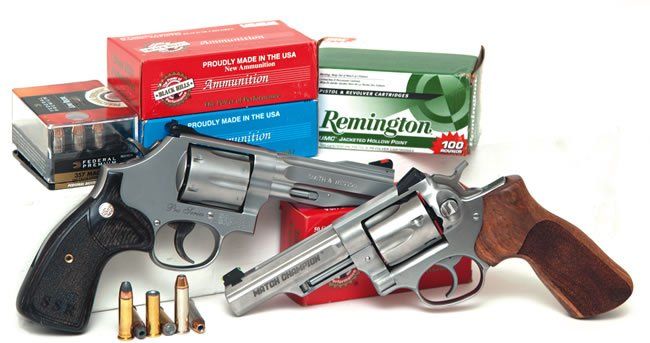
If you believe the revolver is obsolete, think again. The double-action revolver is now more relevant than ever. Haven’t you noticed the trend toward hinged triggers working the action of semi-automatic pistols? Based on developing trigger control, a double-action revolver may now be a more appropriate training device than the typical single-action-only rimfire pistols so often used to introduce beginners to shooting a handgun. The vast majority of double-action revolvers can also be fired single action simply by thumbing back the hammer. This accommodates the arthritic or partially disabled. In addition, you can utilize the same revolver to develop trigger control for single action as well as double action only and double action/single action handguns. Revolvers employ fixed barrels, making them inherently more accurate than semi-automatic pistols wherein the barrel and slide (including the sights) move in and out of position with every shot.
You can leave a revolver loaded for the life of the ammunition and, unlike a magazine-fed pistol, its ability to cycle rounds will not be affected by magazine-spring fatigue. Nor will the outline or shape of the bullets interfere with chambering. You can safely load frangible rounds, such as rat shot or snake-shot, without malfunction and even load a mix of both high-velocity and low-velocity ammunition, again without malfunction.
But our motivation for testing the Ruger GP100 Match Champion and Smith & Wesson Pro Series 686 SSR 357 Magnum revolvers is more exciting than any of the arguments above. These guns were designed to compete in the Stock Service Revolver division of International Defensive Pistol Association or, IDPA. Both revolvers meet the physical requirements to be eligible for SSR competition — a maximum barrel length of 4.2 inches or less and a maximum unloaded weight of 43 ounces or less. Stock Service Revolvers may have the capability to chamber additional rounds, but in competition, no more than six rounds may be loaded at any time.
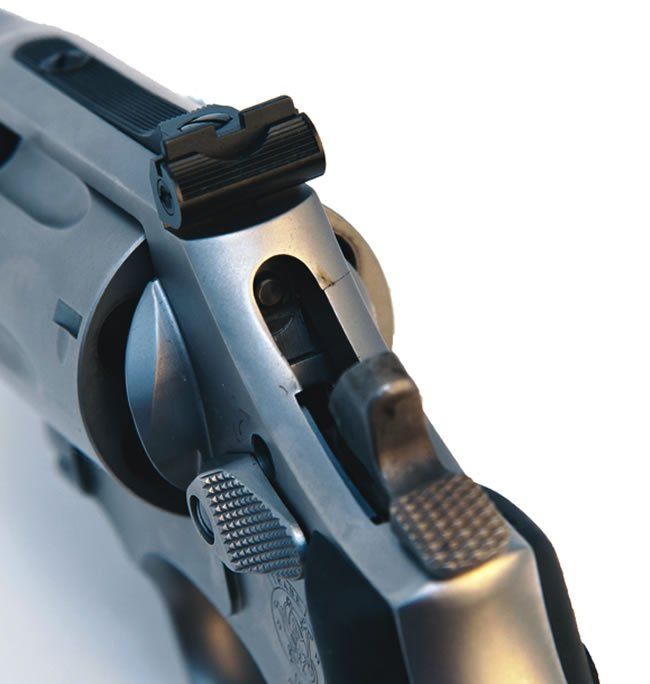
Whereas these guns are recognized as 357 Magnum revolvers, their versatility allows them to fire 38 Special ammunition as well. And IDPA rules allow for the shooter to choose either caliber for competition. For our tests, we chose two rounds of 38 Special and one variety of 357 Magnum. Our 38 Special rounds were Remington 125-grain +P semi-jacketed hollowpoints and Black Hills 148-grain hollow-based wadcutter rounds. The Remingtons are an intermediate-power defense load, and the lead wadcutters are a popular target load commonly used in competitions that demand accuracy, such as NRA Action Pistol, PPC, and Bullseye. Our choice of magnum rounds was Federal 130-grain Hydra-Shok Personal Defense Low Recoil hollowpoint ammunition. To assess accuracy, we fired a series of five-shot groups single action only from a sandbag rest. Test distance was 25 yards. To determine average velocity, we fired shots from all six chambers across an Oehler Research Model 35P printing chronograph.
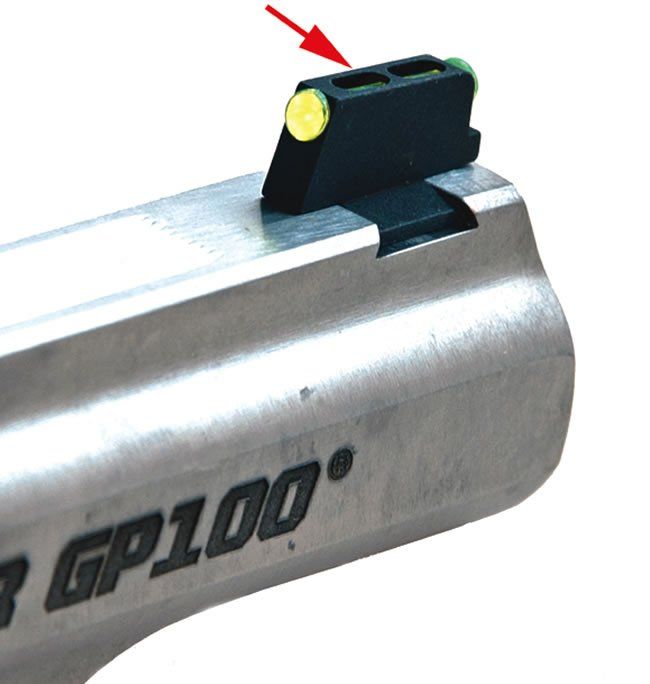
Smith & Wesson Pro Series 686 SSR
No. 178012 357 Magnum Revolver, $999
At first glance a Smith & Wesson aficionado might mistake the 686 SSR for the 8-round Model 627. Like the large N-frame Model 627, our test gun offered a tapered underlug, but the 686 series is built on the medium-large L-frame. The SSR category does not specify the grip-frame profile. This one has a round butt, which offers a smaller profile, making the revolver easier to conceal. A highlight of the SSR was that both a Hogue rubber Mono-Grip and a fancy wood grip were supplied as part of the package.
The 686 SSR’s muted satin stainless finish has become an S&W standard. So has the checkered and relieved cylinder release with key-operated trigger lock located just above it on the left-hand side of the frame. The hammer spur was short and wide, but checkered and easy to find. The fully adjustable rear sight is an old design that still works exceptionally well, in our view. This sight was once the preferred custom upgrade for semi-automatic pistols. The front sight was a ramp design enhanced with an orange color insert. It was held in place by a roll pin. Lockup of the 6-chamber cylinder relied upon the tip of its full-length ejector rod for support. The aforementioned underlug was tapered to make holstering and drawing quicker, but it was still long enough to shroud and protect the ejector rod.
One additional feature that sets this gun apart was that the chambers have been chamfered to hasten loading. This means the 90-degree angle between the rear faces of the cylinder and the individual chambers have been machined to provide a funneling action to hasten loading. This should be standard on all revolvers, but isn’t. Even though the chamfering was mild, we found speed-loading the 686 SSR was faster when compared to unchamfered chamber mouths of the Ruger revolver.
The Smith single-action trigger weighed in at 5.5 pounds, but the double-action press put up 12.0 pounds of fight. We think there was plenty of room for a trigger job that would lighten the action and not make it a liability on the street, if carried. When pulling the double-action trigger, we heard two clicks, one to release the cylinder and another to settle the chamber behind the forcing cone. Then there was a sliding action that felt just a little sticky if you were pressing slowly. Both test revolvers rotated the cylinder counter-clockwise.
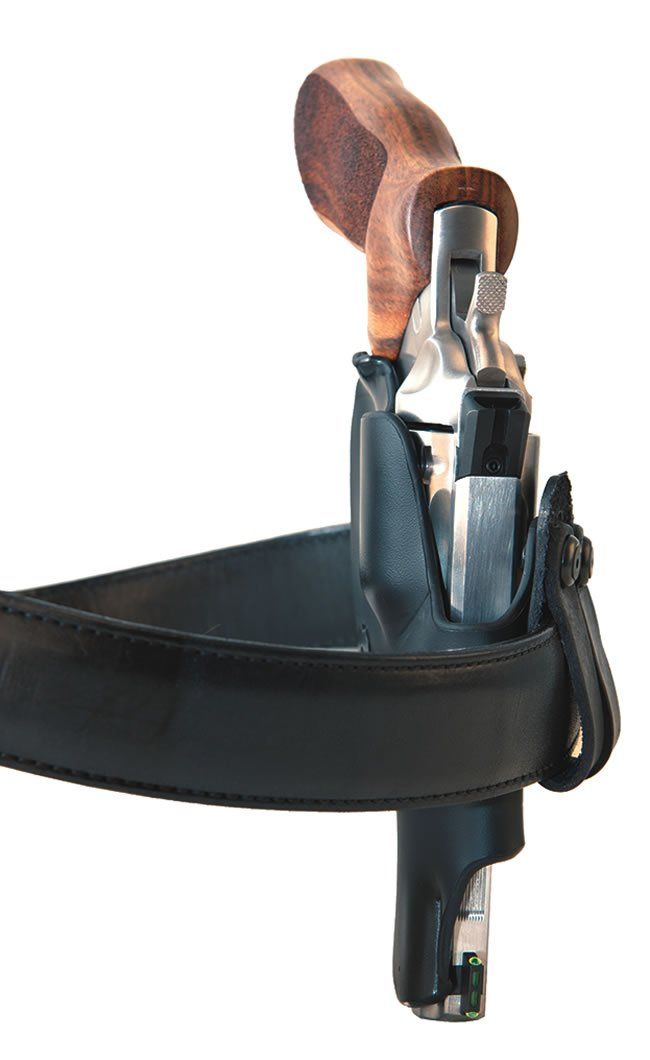
The Smith & Wesson bested the Ruger when firing two of the three test rounds. But results were close enough to be within shooter error. The 125-grain Remington 38 Special +P rounds were best, settling five shots into a 2.3-inch-wide group. We found it remarkable that the two remaining rounds, Federal’s 130-grain 357 Magnum Personal Defense rounds and the light-shooting 148-grain wadcutters from Black Hills ammunition, each produced 2.5-inch groups.
Our Team Said: The 686 SSR is pretty much ready to go for IDPA Stock Service Revolver competition. Aficionados will likely choose to lighten the trigger, and this can be achieved by backing off the strain screw, which applies tension to the main spring from the front of the grip frame. But this could also make for unreliable ignition, if taken too far. A professionally applied action job is still the best choice.
Ruger GP100 Match Champion
No. 1754 357 Magnum
Revolver, $899
The Ruger GP100-series revolvers are different from the Smith & Wesson 686s, but both guns were introduced to provide more durability than previous models. The Ruger GP100 replaced the Security Six revolver in about 1986 with innovations such as stronger lockup built into the cylinder crane rather than at the tip of the ejector rod. Another feature that adds strength to the GP100 design is the lack of side plates in the construction of the frame. Plus additional steel was added to critical areas that support the barrel.
Referred to as medium sized (between the 5-shot SP101 and Redhawk double-action revolvers), the grip frame, or butt, of the GP100 was peg-like, making it possible to apply different sized grips, including very small ones to aid concealment. However, being a target and competition model, the priority for this revolver was shooter comfort. The Match Champion’s Hogue Monogrip was a beautiful hardwood featuring graceful swells and stippled panels on each side. The GP100 Match Champion’s satin-stainless-steel surface was brighter than the Smith & Wesson finish of the same name. The Ruger Match Champion is the only GP100 that offers a partial underlug.
Two very recognizable Ruger characteristics were the polished flat-sided hammer and the “push-button” cylinder release. The cylinder release was hinged vertically at its center, so the operator actually must press inward on the rearmost half of the button. Otherwise, we found this design required little or no dexterity to operate.
The sights were a clear departure from those typically found on a revolver, whether fixed or adjustable. Dovetailed and low-mounted, these Novak sights are more often seen mounted on sophisticated carry pistols than on revolvers. The front sight was also dovetailed into the top strap, and we found its visibility to be extraordinary, thanks to a bright-green fiber optic that gathered light from both its front and rear edges as well as from two reliefs cut into the top of the blade. The rear unit was drift adjustable for windage. Changes in elevation could be effected by installing a different-height front-sight blade, but Ruger seems to have struck an effective balance with the supplied front blade.
We liked the thin Ruger trigger with smoothly rounded edges. Tucking it just inside the first joint of the index finger, the shooter could feel the trigger’s slight forward taper move directly to lockup, followed by a smooth, short press to release the hammer. Maximum resistance for the double-action press was 10.5 pounds. The single-action trigger weighed in at 4.0 pounds.
Accuracy results were very close to the Smith & Wesson’s. The Black Hills 148-grain lead wadcutters were best, measuring an average group of 2.3 inches. The Remington 38 Special +P ammunition printed 2.4-inch groups on average. The 357 Magnum rounds expanded to 2.7 inches per five shots, putting the Ruger behind the Smith by only a computed 0.03 inches for all shots fired.
Our Team Said: Long underappreciated despite a sterling record of service, Ruger now has a medium-framed revolver to champion. Cutting a distinctive profile that shouts durability as well as style, the double-action trigger as delivered was smooth and light enough to satisfy most competitive shooters. The single-action trigger was superb. The sights were street worthy as well as suitable for competition. It does need chamfered chamber mouths, a modification that costs about $40.
In deciding between these handguns, we would like to make it clear that we’re going to call the rankings based purely on the guns as delivered, without consideration for the potential of each gun after spending time in the hands of a match-grade gunsmith. The Ruger trigger was very smooth and acceptably light right out of the box — even for a competitive shooter. All it needs is chamfered cylinders to help it speed-load faster. The 686 SSR comes with two very different grips, and this may be a sign that the manufacturer knows it can’t please everyone with a stock offering. On the plus side, the 686 has chamfered cylinders but the machining is mild compared to what most shooters want, so that probably means having the chamfering redone. Nevertheless, S&W should be applauded for offering this feature when nobody else will. On the downside, the 686 trigger, as is, was unnecessarily heavy. It’s amazing how the Smith triggers can be transformed by even a journeyman ‘smith, so we think the maker is simply leaving room for the competitor to have it worked to his or her individual taste. But that may be a lot to ask of the buyer after dropping so much on this expensive six shooter.
Written and photographed by Roger Eckstine, using evaluations from Gun Tests team testers. GT
SmithWessonProseries686ssrno.pdf

























